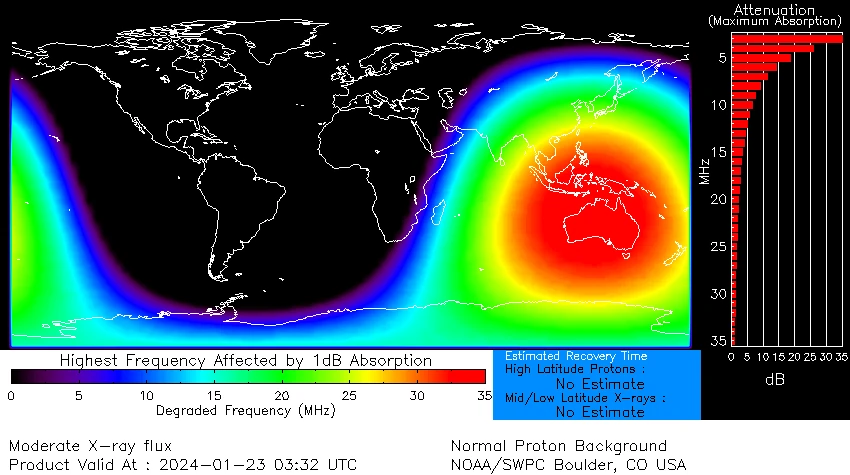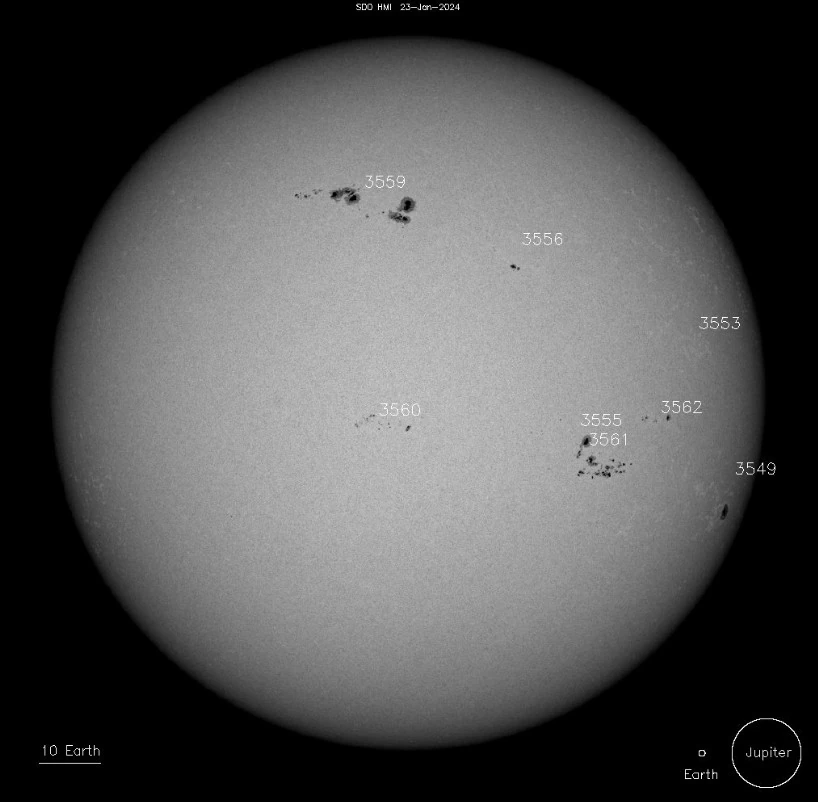An approximately 25 degrees in length solar filament centered near S35W09 began erupting after 09:00 UTC on January 22, 2024, producing an Earth-directed CME. The estimated time of arrival is January 25.
Solar activity reached high levels on January 22 with numerous C- and M-class solar flares, primarily from active regions 3559 (beta-gamma) and 3561 (beta).
At around 09:50 UTC on January 22, a 25-degree solar filament began lifting off the Sun’s southern hemisphere, releasing a notable coronal mass ejection (CME). According to SWPC forecasters, the CME is expected to reach Earth on January 25. While this event is still being analyzed, it is possible enough plasma was ejected our way to produce G1 or stronger geomagnetic storms.
Additionally, an impulsive M5.1 solar flare erupted from Active Region 3559 (beta-gamma) at 03:31 UTC on January 23, 2024.
There were no radio emissions suggesting a coronal mass ejection (CME) was produced during the flare event. Radio frequencies were forecast to be most degraded over Australia and far SE Asia.


Active Region 3559 has a beta-gamma magnetic configuration and is capable of producing more moderate to strong solar flares. In addition, it is currently in a geoeffective position so any CMEs produced by it today and in the days ahead could be Earth-directed.


The region was the source of numerous C- and several M-class solar flares since January 22, including M1.5 and M1.2. Active Region 3561 (beta) has also been contributing with C- and M-class flares since yesterday, including M2.0 and M3.4.
In total, there were 10 M-class solar flares from 06:22 UTC on January 22 to 08:22 UTC on January 23. All of them were produced by regions 3559 and 3561.
Periods of G1 – G2 (Minor-Moderate) geomagnetic storms are likely on January 23 due to the anticipated passage of a CME that left the Sun on January 20. Quiet and unsettled levels are expected on January 24 due to waning CME influences.
References:
1 Forecast Discussion – Issued: 2024 Jan 23 0030 UTC – Prepared by the U.S. Dept. of Commerce, NOAA, Space Weather Prediction Center
Featured image credit: NASA/ESA LASCO C2 and C3, NASA/SDO AIA 304
If you value what we do here, create your ad-free account and support our journalism.
Major X3.3 solar flare erupts behind the SW limb, S2 – Moderate solar radiation storm
Friday, February 9, 2024
Long-duration M5.1 solar flare erupts from Region 3575
Wednesday, February 7, 2024
Long-duration M4.2 solar flare erupts from Region 3575
Tuesday, February 6, 2024
M6.7 solar flare erupts from Region 3559, producing S2 – Moderate solar radiation storm
Monday, January 29, 2024
Complex filament eruption produced Earth-directed CME, impact expected late January 22
Sunday, January 21, 2024
Major X5.0 solar flare erupts from Region 3536 — the strongest flare of Solar Cycle 25
Monday, January 1, 2024
Multiple M-class solar flares and CMEs, possible CME impact on December 27
Monday, December 25, 2023
